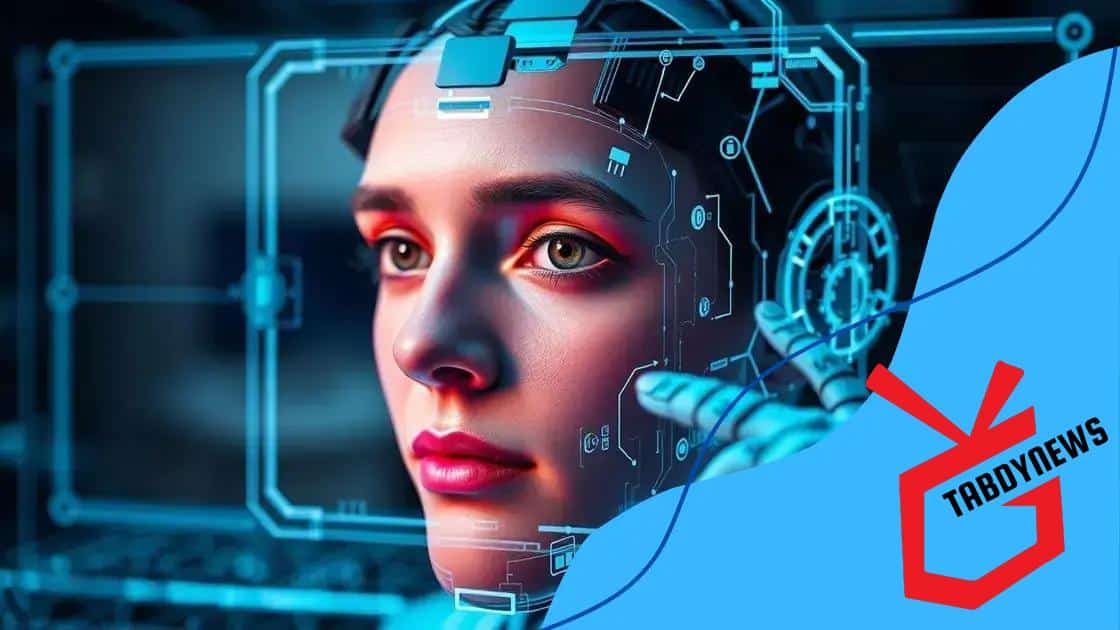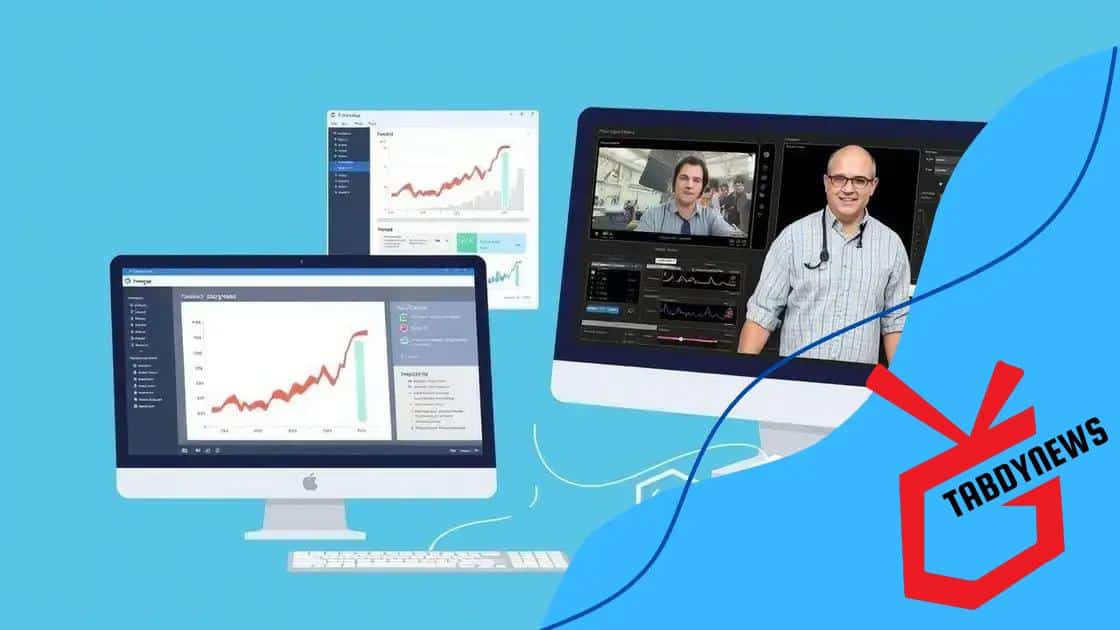AI tools combating deepfake videos: a guide

AI tools combating deepfake videos are essential for authenticating digital content by using advanced detection technologies that identify manipulated media swiftly and accurately.
AI tools combating deepfake videos are becoming crucial as the digital landscape evolves. Have you ever wondered how they help us differentiate between real and fake content? Let’s dive into their significance and functionality.
Understanding deepfake technology
Understanding deepfake technology is essential in today’s digital world. This technology allows users to create incredibly realistic fake videos by manipulating real footage. It utilizes advanced algorithms and machine learning to replace faces or even fabricate entire scenarios. The growing use of deepfake technology raises numerous concerns, especially regarding misinformation.
How Deepfake Technology Works
At its core, deepfake technology employs neural networks, which are designed to learn from vast datasets. These systems can analyze the minute details of one person’s face and replicate them onto another.
This means that even the smallest expressions and movements can be accurately copied. This level of accuracy makes it challenging for the average viewer to discern between real and fake content.
Key Components of Deepfake Technology
- Machine Learning: Algorithms are trained on thousands of images to understand human features.
- Generative Adversarial Networks (GANs): Two neural networks compete against each other, enhancing the realism of the output.
- Data Sources: High-quality video datasets are crucial for training; the more data, the better the results.
- Face Swapping: This is a common technique used to replace one person’s face in a video with another’s.
While deepfake technology has legitimate uses in filmmaking and entertainment, it can also be exploited for malicious purposes. For example, deepfakes can be employed to create fraudulent videos that spread false narratives or damage reputations.
As technology evolves, the line between reality and fiction continues to blur. The challenge lies in creating reliable detection methods to protect against misuse.
Detecting deepfakes is an evolving field, requiring continuous advancements as deepfake creation techniques improve. Monitoring content is vital to combat the spread of misleading information and restores trust in visual media.
The role of AI in combating deepfakes
The role of AI in combating deepfakes is becoming increasingly vital as these technologies evolve. AI can help identify manipulated content swiftly and with high accuracy. By using advanced algorithms, AI systems can analyze videos and detect subtle inconsistencies that may reveal a deepfake.
AI Detection Techniques
Several techniques are employed by AI to combat deepfakes effectively. One common method is a deep learning approach, where neural networks are trained on large datasets of both real and fake videos. This training allows the AI to understand the differences and identify fake content.
- Image Analysis: AI examines pixels closely to find alterations in texture and lighting that are not visible to the human eye.
- Facial Recognition: By comparing facial movements, AI can spot mismatches between the audio and video.
- Audio Analysis: This checks if the voice matches the mouth movements, highlighting any inconsistencies.
While AI plays a crucial role in detecting deepfakes, it is not infallible. As deepfake technology continues to improve, detection methods must also advance. This cat-and-mouse game between creators and detectors keeps evolving. Researchers are optimistic about developing more effective strategies to stay one step ahead.
Additionally, AI can assist in creating tools that are user-friendly, empowering individuals and organizations to monitor content easily. Public awareness campaigns utilizing AI technology may also help educate people about the risks of deepfakes and encourage critical consumption of media.
Key tools to detect deepfakes

Key tools to detect deepfakes play a vital part in maintaining the integrity of digital content. Many developers and researchers are creating software and systems that help users identify manipulated media. These tools use various technologies, including machine learning and computer vision, to analyze videos and images closely.
Popular Detection Tools
Several well-known tools and platforms have emerged to assist in identifying deepfakes. Each tool has unique features and operates using different methodologies to ensure accuracy.
- Deepware Scanner: This tool performs a comprehensive analysis of videos, detecting signs of manipulation with ease.
- Sensity AI: Sensity provides deepfake detection services tailored for various industries, including entertainment and security.
- Deepfake Detection Challenge: A collaborative project promoting advancements in detection tech, offering challenges for developers.
- Microsoft Video Authenticator: This tool analyzes images and videos and gives a confidence score indicating the likelihood of manipulation.
Utilizing these tools helps both professionals and the public navigate the digital landscape more safely. It becomes crucial to implement such solutions, especially as deepfakes become more accessible to the general public.
By combining these detection technologies with user education, we can foster a more informed society. Users should learn how to recognize warning signs of deepfakes and rely on these key tools to verify the authenticity of digital content.
Challenges in identifying deepfake content
Challenges in identifying deepfake content are significant as this technology becomes more sophisticated. The increasing realism of deepfake videos makes it difficult for the average viewer to distinguish between authentic and manipulated media. This poses serious risks, especially in areas like politics, journalism, and personal privacy.
Technical Difficulties
One major challenge is the rapid advancement of deepfake creation methods. As creators become more skilled and the tools they use improve, detection becomes increasingly complex. Deepfake videos can mimic human facial expressions and movements with such precision that traditional detection methods struggle to keep up.
- High-quality production: As the quality of fake videos improves, artifacts become less noticeable, making detection difficult.
- Variability of content: Different styles and techniques can be used to create deepfakes, complicating the detection process.
- Circumvention of current methods: Creators often adapt their techniques to bypass detection algorithms, leading to an ongoing arms race.
Moreover, misinformation spreads rapidly; people often share deepfake content before verifying its authenticity. This behavior amplifies the challenges faced by society as a whole when trying to combat fake news.
Another challenge is the lack of public awareness regarding deepfake technology. Many individuals do not understand the potential dangers or how to identify manipulated media. Education and awareness campaigns can help empower users to spot potential deepfakes.
Overall, as technology evolves, so must our understanding and methods of detection. A collaborative effort between technology developers, researchers, and the public is essential to address these challenges effectively.
Future trends in deepfake deterrence
Future trends in deepfake deterrence are evolving rapidly as technology advances. As deepfakes become increasingly sophisticated, new methods of detection and prevention are emerging to combat their potential misuse. The future will likely focus on enhancing technology and fostering greater public awareness.
Advancements in Detection Technology
One expected trend is the advancement of detection algorithms. These algorithms will use artificial intelligence to analyze videos more effectively. They aim to spot inconsistencies that can indicate a deepfake.
- Real-time detection: Future tools will likely allow users to verify content as they view it, making immediate identification possible.
- Blockchain technology: This can provide a reliable way to authenticate videos at their source, ensuring they haven’t been altered.
- Collaborative databases: Sharing detection data among organizations will enhance detection methods across different platforms.
Beyond technology, public awareness will play a crucial role in deepfake deterrence. Educating people about the potential risks of deepfakes can empower them to question suspicious content. As more individuals understand the signs of manipulation, the impact of deepfakes can be mitigated.
Additionally, social media platforms are beginning to take proactive steps. These platforms may implement stricter policies and tools to flag or remove deepfake content. Encouraging responsible sharing and creating reporting systems will help address the issue effectively.
Finally, ongoing research into deepfake creation methods will allow developers to stay ahead of malicious actors. By understanding how deepfakes are made, better countermeasures can be developed. Combining these efforts will aid in creating a safer digital landscape.
In conclusion, understanding and combating deepfakes is essential in our digital age. As technology continues to evolve, so do the challenges associated with identifying manipulated content. By investing in advanced detection tools and fostering public awareness, we can create a society better equipped to recognize and respond to deepfakes. Together, we can ensure that digital integrity is maintained, making our online experiences safer and more authentic.
FAQ – Frequently Asked Questions about Deepfake Technology
What are deepfakes?
Deepfakes are realistic-looking fake videos or audio recordings created using artificial intelligence, often by swapping faces or altering voices.
How can I identify a deepfake?
You can identify deepfakes by looking for unnatural facial movements, mismatched audio, or using specialized detection tools designed to spot manipulation.
Why are deepfakes a concern for society?
Deepfakes can spread misinformation, damage reputations, and erode trust in digital media, posing threats to personal privacy and public discourse.
What steps can be taken to combat deepfakes?
Combatting deepfakes involves using detection technology, educating the public about the risks, and developing policies to regulate their usage effectively.





